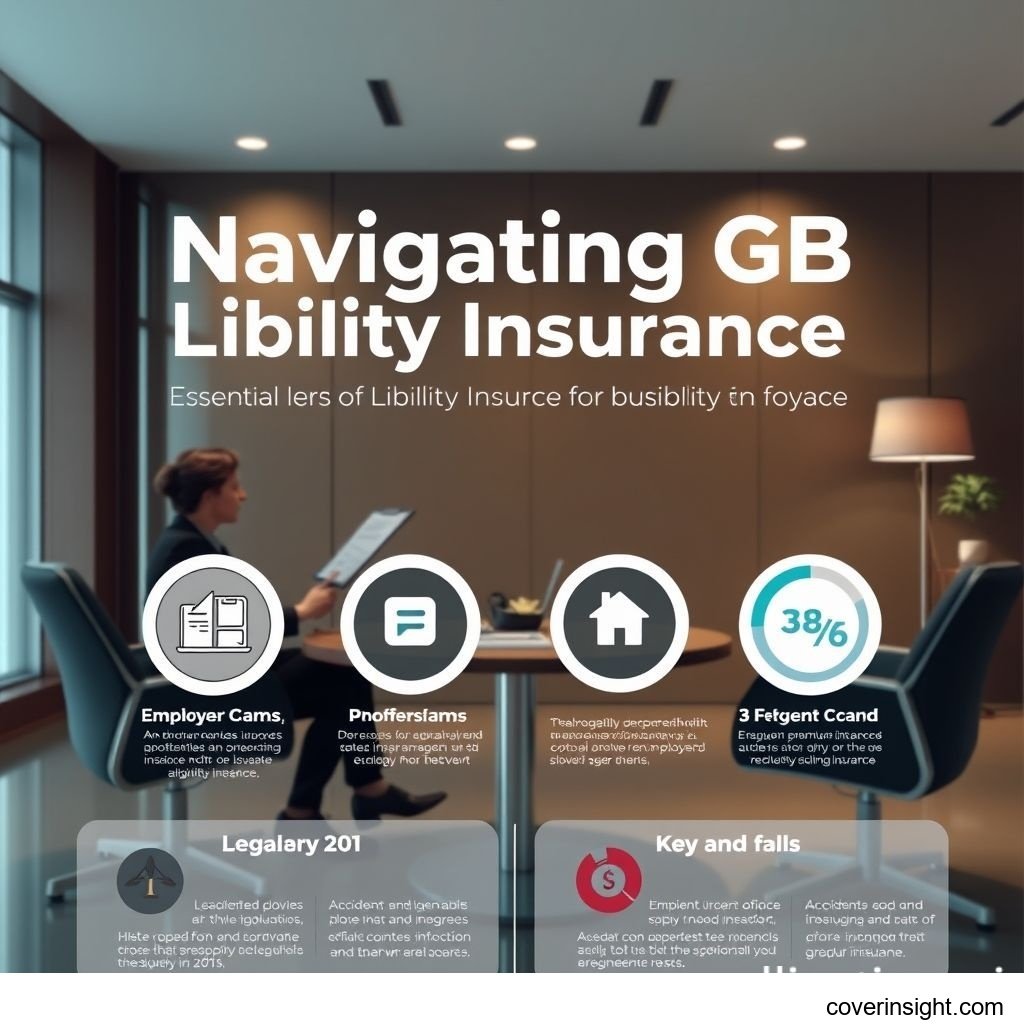Introduction
Navigating the landscape of business insurance in Great Britain can be complex, but one cornerstone requirement for almost all employers is employers' liability insurance. As we approach 2025, understanding the nuances of this vital coverage is not just about compliance; it's about safeguarding your business, your employees, and your financial future. This comprehensive guide will equip you with the knowledge to ensure your business remains protected and compliant with the latest regulations, highlighting why this insurance is an indispensable part of your risk management strategy.
Legal Obligations and Employers' Liability Insurance
In Great Britain, the requirement for employers' liability insurance is not merely a recommendation but a legal imperative. The primary aim of this insurance is to protect your employees should they suffer an injury or illness as a result of their work. Without adequate coverage, your business could face significant financial repercussions.
The Employers' Liability (Compulsory Insurance) Act 1969
The foundation of this obligation lies within the Employers' Liability (Compulsory Insurance) Act 1969. This Act mandates that most employers must have employers' liability insurance to cover claims from employees for workplace injuries or illnesses. The law requires a minimum cover of £5 million, though most policies offer at least £10 million as standard. Failure to comply can lead to severe penalties, including daily fines. This legal framework underscores the importance of not just having a policy, but having one that meets the statutory requirements and is kept up-to-date. Employers should regularly review their policy details to ensure they remain compliant.
Exemptions to the Rule
While the Act is broad, certain limited exemptions do apply. These include:
-
Most public organisations, such as government departments and local authorities.
-
Family businesses where all employees are closely related (e.g., a husband and wife business, if they are the only employees).
-
Companies that have no employees other than the owner, provided the owner owns at least 50% of the share capital.
-
Certain specific bodies, like NHS trusts and health service bodies.
It's crucial for businesses to verify if they genuinely fall under an exemption. If there's any doubt, obtaining employers' liability insurance is always the safest course of action to avoid legal penalties and potential liabilities. Even if exempt, many businesses still choose to purchase this coverage for comprehensive protection.
Coverage Details
Understanding what your employers' liability insurance policy entails is fundamental to leveraging its benefits fully. This section details typical inclusions and common exclusions.
What’s Included
A standard employers' liability insurance policy is designed to cover the costs associated with defending or settling a claim made by an employee for illness or injury sustained during their employment. This typically includes:
-
Legal Fees: Costs incurred in defending a claim, irrespective of the outcome.
-
Compensation Payments: Financial awards or settlements made to the injured or ill employee.
-
Medical Expenses: Where applicable, costs for medical treatment or rehabilitation directly related to the workplace incident.
-
Loss of Earnings: Compensation for an employee's lost income due to their injury or illness.
-
Historical Claims: Coverage for claims arising from incidents that occurred during the policy period, even if the claim is made years later.
This robust coverage ensures that businesses are not financially crippled by unforeseen events, providing peace of mind and supporting employee welfare.
Common Exclusions
While comprehensive, employers' liability insurance does have limitations. Common exclusions may include:
-
Injuries to Non-Employees: This policy does not cover injuries to visitors, clients, or members of the public; public liability insurance addresses these risks.
-
Deliberate Acts: Claims arising from intentional harm caused by the employer or employees.
-
Overseas Incidents: Incidents occurring outside the specified geographical scope of the policy (usually Great Britain).
-
Employees Not Legally Declared: Any employees not declared to the insurer at the time of policy purchase or renewal.
-
Contractual Liabilities: Liabilities assumed under contract that are not directly related to employee injury or illness (e.g., breaches of contract with third parties).
-
Professional Negligence: Claims related to professional advice or services provided, which fall under professional indemnity insurance.
It is vital to read your policy documents carefully to understand the precise scope of your employers' liability insurance and identify any gaps in coverage that might require additional policies.
Specific Situations: Contractor and Trustee Liability
The scope of liability can extend beyond direct employees, encompassing scenarios involving contractors and trustees. Understanding these specific areas is crucial for comprehensive protection.
Contractor Liability Requirements
For businesses engaging independent contractors, the question of contractor liability requirements often arises. While contractors are typically self-employed and responsible for their own insurance, the line can sometimes blur. If a contractor works under your direct supervision, uses your equipment, or is integrated into your operational structure in a way that resembles employment, they might, in some circumstances, be considered an 'employee' for the purposes of employers' liability insurance.
It's prudent to:
-
Clearly define the working relationship in a written contract.
-
Ensure contractors have their own appropriate insurance (e.g., public liability, professional indemnity).
-
Consult with your insurer or legal counsel if you have any doubts about a contractor's status to avoid potential pitfalls where your employers' liability insurance might inadvertently apply, or where you could be deemed liable. This proactive approach helps mitigate risks.
Trustee Liability Coverage
Trustees, particularly those overseeing charities, pension funds, or community organisations, face unique liability challenges. Trustee liability coverage protects individuals who serve as trustees from claims of wrongful acts committed in their capacity as fiduciaries. While distinct from employers' liability insurance, it's often a crucial consideration for organisations that also employ staff.
Key aspects of trustee liability include:
-
Breach of Duty: Claims arising from perceived failures in duties owed to beneficiaries or the organisation.
-
Mismanagement of Funds: Allegations of financial impropriety or poor investment decisions.
-
Error or Omission: Mistakes made in decision-making that lead to financial loss or reputational damage for the trust or charity.
For organisations employing staff and managed by trustees, a comprehensive insurance portfolio would likely include both employers' liability insurance to protect employees and trustee liability coverage to protect the trustees themselves. This dual protection offers a robust defence against a wide range of potential claims.
Cost Analysis
Understanding the factors that influence the cost of employers' liability insurance and how to potentially reduce premiums is key to effective budgeting.
Price Factors
The premium for employers' liability insurance is not fixed and varies significantly based on several factors. Insurers assess the level of risk associated with your business to determine the appropriate cost. Key price factors include:
-
Industry Sector: High-risk industries (e.g., construction, manufacturing, chemicals) typically pay higher premiums than low-risk sectors (e.g., office-based administrative services) due to increased potential for accidents.
-
Number of Employees: More employees generally means a higher risk exposure, leading to higher premiums.
-
Payroll Size: The total remuneration paid to employees can be a factor, as it reflects the scale of the workforce.
-
Claims History: Businesses with a history of past claims will likely face higher premiums, as they are deemed a higher risk.
-
Risk Management Practices: Businesses with robust health and safety procedures, training, and accident prevention measures may receive lower premiums.
-
Policy Limit: Opting for a higher indemnity limit (e.g., £20 million instead of the statutory £5 million) will increase the premium.
-
Business Location: Certain geographical areas might be associated with different risk profiles or claims frequencies.
Saving Tips
While employers' liability insurance is a mandatory expense, there are strategies businesses can employ to potentially reduce their premiums without compromising on essential coverage.
-
Prioritise Health and Safety: Implement rigorous health and safety protocols. A strong safety record and documented risk assessments can demonstrate lower risk to insurers. Consider pursuing relevant certifications.
-
Review Employee Numbers Accurately: Ensure you're only paying for the exact number of employees you have. Update your insurer promptly if your workforce size changes.
-
Compare Quotes: Don't settle for the first quote. Use brokers or comparison sites to get multiple quotes from different providers. This competitive approach often yields better rates for employers' liability insurance.
-
Increase Excess: Opting for a higher voluntary excess (the amount you pay towards a claim before the insurer steps in) can reduce your premium, but ensure it's an amount your business can comfortably afford.
-
Bundle Policies: Many insurers offer discounts when you purchase multiple policies (e.g., public liability, professional indemnity, and employers' liability insurance) from them. Consider consolidating your insurance needs with one provider. You can find comprehensive bundles on sites like GB Insurance Home.
-
Maintain a Clean Claims Record: While not always controllable, a history free of claims will generally result in more favourable premiums.
Choosing the Right Employers' Liability Insurance Provider
Selecting the appropriate employers' liability insurance provider is a critical decision for any business. It's not just about the lowest price, but about securing reliable coverage that truly protects your assets and reputation.
Key Considerations
When evaluating potential insurance providers for your employers' liability insurance, several factors should guide your decision:
-
Reputation and Financial Stability: Choose an insurer with a strong reputation for paying claims and robust financial health. Resources like the Financial Conduct Authority and the Association of British Insurers can offer insights into an insurer's standing.
-
Customer Service and Claims Handling: A good provider offers efficient and supportive customer service, particularly when you need to make a claim. Look for reviews or testimonials regarding their claims process.
-
Policy Inclusions and Exclusions: Carefully compare what each policy includes and excludes. Don't assume all employers' liability insurance policies are identical. Pay attention to limits, specific conditions, and any endorsements.
-
Flexibility and Customisation: Does the insurer offer policies that can be tailored to your specific business needs? Your business may have unique risks that require specific adjustments to a standard policy.
-
Value for Money: While cost is a factor, focus on value rather than just the cheapest premium. A slightly more expensive policy might offer superior coverage or service that proves invaluable in the long run.
-
Industry Expertise: Some insurers specialise in certain industries. An insurer with experience in your sector may better understand your specific risks and offer more appropriate coverage for your employers' liability insurance.
Policy Review and Renewal
Your business is dynamic, and so should be your insurance coverage. Regularly reviewing your employers' liability insurance policy is essential to ensure it remains fit for purpose.
-
Annual Review: Conduct a thorough review of your policy at least annually, preferably before renewal. Assess any changes in your business operations, employee numbers, new risks, or changes in legislation.
-
Business Changes: Inform your insurer immediately of significant changes such as:
-
New locations or expansion.
-
Changes in the nature of your business activities.
-
Acquisition of new machinery or equipment.
-
Significant increase or decrease in staff.
-
Engagement of a new class of contractor liability requirements.
-
-
Documentation: Maintain meticulous records of all safety measures, training provided, and any incidents (even minor ones). Good documentation can support your case in the event of a claim.
By staying proactive in managing your employers' liability insurance, you ensure continuous compliance and optimal protection for your business. For more guidance on insurance best practices, consider exploring Insurance Resources Global.
FAQs
Here are some frequently asked questions about employers' liability insurance:
How much does employers' liability insurance cost?
The cost of employers' liability insurance varies widely. Premiums can range from a few hundred pounds annually for small, low-risk businesses to several thousands for larger, high-risk operations. Factors such as industry, number of employees, and claims history significantly influence the price.
What affects premiums?
Premiums for employers' liability insurance are primarily affected by:
-
Business type and industry: Higher risk industries pay more.
-
Number of employees: More staff equals higher potential risk.
-
Payroll size: Larger payrolls can indicate more exposure.
-
Claims history: A history of claims typically leads to higher costs.
-
Health and safety measures: Strong risk management can lower premiums.
-
Coverage limit: Opting for higher coverage than the minimum increases the cost.
Is it mandatory?
Yes, employers' liability insurance is mandatory for most businesses in Great Britain that employ staff, under the Employers' Liability (Compulsory Insurance) Act 1969. There are very limited exemptions, primarily for close family businesses or certain public bodies.
How to choose?
To choose the best employers' liability insurance policy, you should:
- Assess your specific business risks and needs.
- Compare quotes from multiple reputable insurers or use a broker.
- Evaluate the insurer's reputation, customer service, and claims handling.
- Scrutinise policy terms, including inclusions, exclusions, and limits.
- Consider combining it with other policies for potential discounts.
Consequences of no coverage?
Operating without the mandatory employers' liability insurance can lead to severe consequences:
-
Legal Penalties: Fines of up to £2,500 for every day you are uninsured.
-
Unlimited Liability: If an employee makes a successful claim for injury or illness, your business will be solely responsible for all legal costs and compensation payments, which can be substantial and potentially bankrupt the business.
-
Reputational Damage: Lack of compliance can severely damage your business's reputation and trustworthiness.







Comments